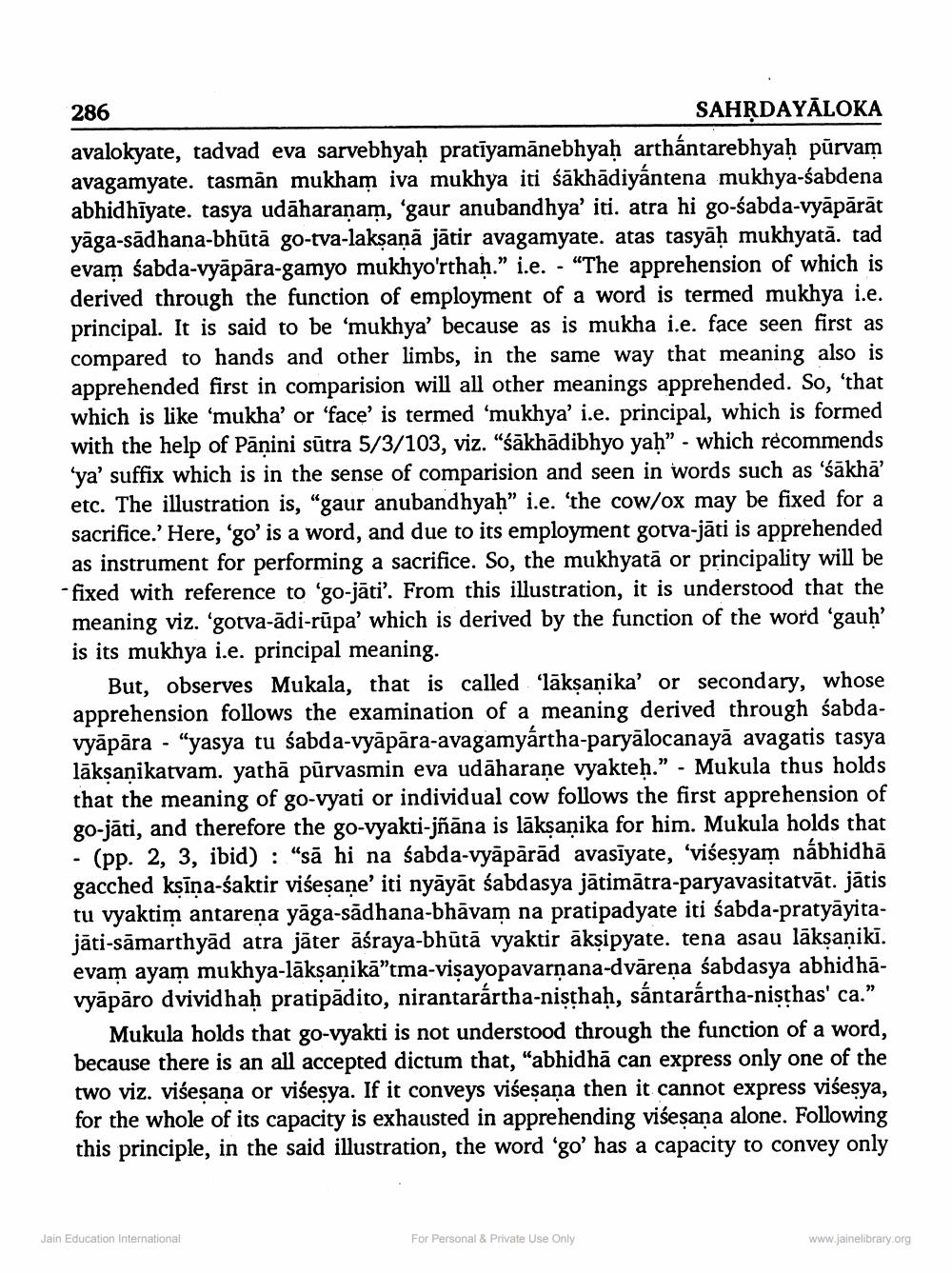________________
286
SAHRDAYĀLOKA avalokyate, tadvad eva sarvebhyaḥ pratīyamānebhyah arthántarebhyah pūrvam avagamyate. tasmān mukham iva mukhya iti śākhādiyántena mukhya-śabdena abhidhīyate. tasya udāharanam, gaur anubandhya' iti. atra hi go-śabda-vyāpārāt yāga-sādhana-bhūtā go-tva-laksaņā jātir avagamyate. atas tasyāḥ mukhyatā. tad evam śabda-vyāpāra-gamyo mukhyo'rthah.” i.e. - "The apprehension of which is derived through the function of employment of a word is termed mukhya i.e. principal. It is said to be 'mukhya' because as is mukha i.e. face seen first as compared to hands and other limbs, in the same way that meaning also is apprehended first in comparision will all other meanings apprehended. So, 'that which is like 'mukha' or 'face' is termed 'mukhya' i.e. principal, which is formed with the help of Pāṇini sūtra 5/3/103, viz. “śākhādibhyo yah” - which recommends 'ya' suffix which is in the sense of comparision and seen in words such as 'śākhā' etc. The illustration is, "gaur anubandhyaḥ” i.e. 'the cow/ox may be fixed for a sacrifice.' Here, 'go' is a word, and due to its employment gotva-jāti is apprehended as instrument for performing a sacrifice. So, the mukhyatā or principality will be - fixed with reference to 'go-jāti'. From this illustration, it is understood that the meaning viz. 'gotva-ādi-rūpa' which is derived by the function of the word 'gauh' is its mukhya i.e. principal meaning.
But, observes Mukala, that is called 'laksanika' or secondary, whose apprehension follows the examination of a meaning derived through śabdavyāpāra - "yasya tu sabda-vyāpāra-avagamyártha-paryālocanayā avagatis tasya lāksanikatvam. yathā pūrvasmin eva udāharane vyakteh.” - Mukula thus holds that the meaning of go-vyati or individual cow follows the first apprehension of go-jāti, and therefore the go-vyakti-jñāna is lāksanika for him. Mukula holds that - (pp. 2, 3, ibid) : "sā hi na sabda-vyāparād avasiyate, 'višesyam nábhidha gacched ksīna-śaktir viśesaņe' iti nyāyāt sabdasya jātimātra-paryavasitatvāt. jātis tu vyaktim antarena yāga-sādhana-bhāvam na pratipadyate iti śabda-pratyāyitajāti-sāmarthyād atra jāter āśraya-bhūtā vyaktir ākṣipyate. tena asau lākṣaṇiki. evam ayam mukhya-lākṣaṇikā”tma-visayopavarnana-dvāreņa sabdasya abhidhāvyāpāro dvividhaḥ pratipadito, nirantarártha-nisthah, sántarártha-nișthas' ca.”
Mukula holds that go-vyakti is not understood through the function of a word, because there is an all accepted dictum that, "abhidhā can express only one of the two viz. viśesana or viśesya. If it conveys viśesana then it cannot express viśesya, for the whole of its capacity is exhausted in apprehending viśesana alone. Following this principle, in the said illustration, the word 'go' has a capacity to convey only
Jain Education International
For Personal & Private Use Only
www.jainelibrary.org




